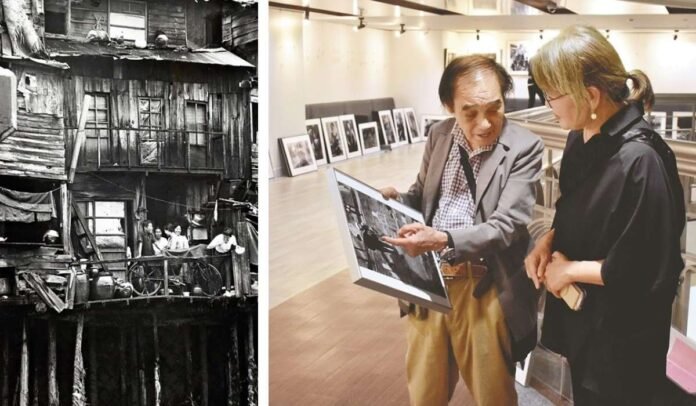This photo by Shisei Kuwabara shows people looking out from a hut at the Cheonggyecheon Stream in central Seoul in 1965.
1:00 JST, April 30, 2024
South Korean director Ko Hee-young, 57, is producing a documentary about photojournalist Shisei Kuwabara, 87, known for photographing Minamata disease and South Korea at the time Japan and South Korea were restoring bilateral ties.
The film is tentatively titled “Hodoshashinka Kuwabara Shisei” (Photojournalist Shisei Kuwabara).
“There is a profound human story in every photo [by Kuwabara]”, Ko said. “I would like the world to get to know this photographer.”

Shisei Kuwabara, left, and Ko Hee-young talk to each other.
Ko plans theatrical releases of the film in both Japan and South Korea next year.
It was in 1964 that Kuwabara began taking photographs in South Korea, documenting historical moments such as student protests against the signing of the Treaty on Basic Relations between Japan and the Republic of Korea, and the deployment of troops by the South Korean armed forces in South Korea. Vietnam. Those photos have become important historical source material for those learning the modern history of South Korea.
Ko is an accomplished film director who received a Special Jury Prize at the Jeonju International Film Festival in South Korea. When she made a documentary about a South Korean potter, Kuwabara gave her permission to use relevant photos he had taken. The photos apparently left a profound impact on Ko due to their deeply dramatic nature.
Production of the film about Kuwabara’s life continued after a South Korean government organization agreed to subsidize the film. Kuwabara provided Ko with approximately 500 photographs for use in the film. Among them are photographs that depict certain aspects of South Korean society that citizens at the time did not want foreigners to see.
An example of this is the clusters of huts near the Cheonggyecheon Stream in central Seoul. When Kuwabara pointed his camera at the houses, a South Korean photographer friend told him, “Don’t photograph that place too much,” with a concerned look.
“When I see those photos now, I think he did a really good job capturing those places,” Ko said. “He took the photos unbiased, as if he were a boy.”
She wonders why Kuwabara clicked the shutter at certain times. By making the film, Ko hopes to get closer to Kuwabara’s awareness of the problems in the backgrounds of those photos, as well as his philosophy and values.
“For young people, both Minamata disease and the South Korean student protests could be a thing of the past,” Kuwabara said. “But history is continuous. I would be happy if people keep my photos in the corner of their memories and use them to help understand the present.”



